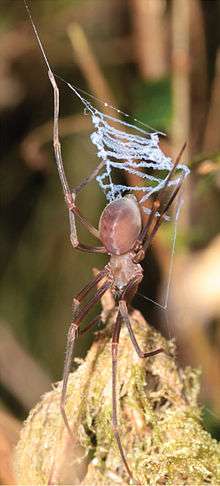Cribellum

The cribellum is a silk spinning organ found in certain spiders. Unlike normal spinnerets, the cribellum consists of one or more plates covered in thousands of tiny spigots.[1] These spigots produce extremely fine fibers which are combed out by the spider's calamistrum, producing silk with a wooly texture. The fibers are so small in diameter that prey insects easily become entangled in them, without any glue needed. The spiders then bite them before they can escape.
The cribellum is a functional homolog of the anterior median spinnerets of Mesothelae and Mygalomorphae, which do not have a cribellum.
The presence or absence of a cribellum is used to classify araneomorph spiders into the cribellate and ecribellate (not cribellate) type. The distinction can be used to study evolutionary relationships. However, in 1967 it was discovered that there are many families with both cribellate and ecribellate members (Lehtinen, 1967). Today, it is believed that the precursor of all Araneomorphae was cribellate (symplesiomorphy), and that this function was lost in some araneomorph spiders secondarily (Coddington & Levy, 1991). Many of these still retain a colulus, which is thought to be a reduced cribellum, and is of unknown function. However, some "ecribellate" spiders seem to have evolved independently, without cribellate precursors (Foelix, 1979).
Only about 180 genera in 23 families (1991) still contain cribellate members, although the diverse Australian cribellate fauna is still mostly undescribed. However, that fauna may be an example of high diversity in Australian animals that are only relicts in other regions of the world, like the marsupials (Coddington & Levy, 1991).
Cribellate taxa are not very speciose, and for nearly all cribellate-ecribellate sister clades the cribellate lineage is less diverse (Coddington & Levy, 1991), for example:
- Haplogynae: cribellate Filistatidae ca. 100 species, all others (mostly ecribellate) ca. 3,000 species
- Entelegynae: cribellate Deinopoidea ca. 320 species, ecribellate Araneoidea ca. 11,000 species
Cribellate families
22 families of araneomorph spiders (Agelenidae, Amaurobiidae, Amphinectidae, Austrochilidae, Ctenidae, Deinopidae, Desidae, Dictynidae, Eresidae, Filistatidae, Gradungulidae, Hypochilidae, Miturgidae, Neolanidae, Nicodamidae, Oecobiidae, Psechridae, Stiphidiidae, Tengellidae, Titanoecidae, Uloboridae, Zoropsidae) contain at least some cribellate spiders (Griswold et al. 1999). While some of these families are entirely cribellate, others contain both cribellate and ecribellate species.
Diatom cribellum
The outside layer of a diatom is also called a cribellum. It consists of a thin siliceous membrane covered with small pores.[2]
References
- ↑ Foelix, Rainer F. (1996). Biology of Spiders (2 ed.). Oxford University Press. pp. 118–122.
- ↑ Gordon, Richard; Dusan Losic; Mary Ann Tiffany; Stephen S. Nagy; Frithjof A.S. Sterrenburg (February 2009). "The Glass Menagerie: diatoms for novel applications in nanotechnology". Trends in Biotechnology. 27 (2): 116–27. doi:10.1016/j.tibtech.2008.11.003. PMID 19167770.
- Lehtinen, P.T. (1967). Classification of the Cribellate spiders and some allied families, with notes on the evolution of the suborder Araneomorpha. Ann. Zool. Fennici 4: 199-467.
- Foelix, Rainer F. 1979. Biologie der Spinnen. Georg Thieme Verlag Stuttgart. ISBN 3-13-575801-X
- Coddington, J.A. & Levi, H.W. (1991). Systematics and Evolution of Spiders (Araneae). Annu. Rev. Ecol. Syst. 22: 565-592.
- Eberhard, William G. and Pereira, Flory. 1993. Ultrastructure of cribellate silk of nine species in eight families and possible taxonomic implications (Araneae: Amaurobiidae, Deinopidae, Desidae, Dictynidae, Filistatidae, Hypochilidae, Stiphidiidae, Tengellidae). Journal of Arachnology 21(3): 161-174. PDF
- Huber, B.A. (1994): Spermophore morphology reveals a new synapomorphy of Oecobius and Uroctea (Araneae, Oecobiidae). Journal of Arachnology 22: 73-74. PDF
- Griswold, C.E., Coddington, J.A., Platnick, N.I. and Forster, R.R. (1999). Towards a Phylogeny of Entelegyne Spiders (Araneae, Araneomorphae, Entelegynae). Journal of Arachnology 27: 53-63. PDF
External links
- The Spider - Web and Silk (description and pictures)
- Cribellate silk vs. sticky silk
- The Evolution of Web Usage in Spiders
